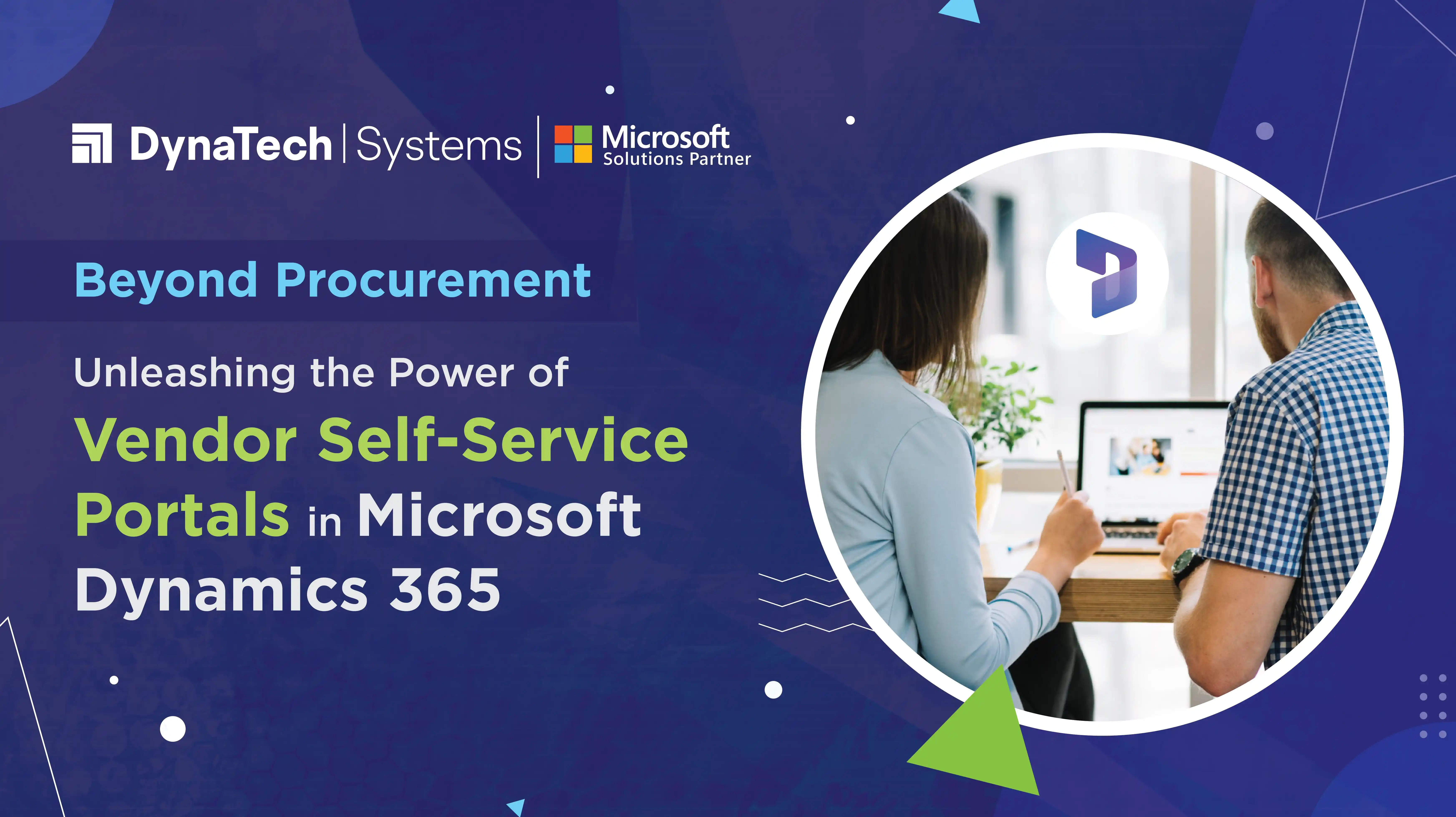In today’s economy, businesses rise or fall based on the strength of their supply chains. But while enterprise systems evolve, procurement processes often remain embarrassingly stuck in the past—relying on email trails, Excel sheets, and overburdened procurement desks to manage thousands of vendors. It's like running a Formula 1 car with a dial-up engine.
The vendor is no longer a passive participant. They are a crucial cog in the success engine of modern organizations. What they need is complete transparency, automation, and real-time access—not PDFs buried in inboxes. What you need is agility, accuracy, and fewer bottlenecks. Enter the Vendor Self-Service Portal in Microsoft Dynamics 365.
This isn’t just a digital dashboard. It’s a complete transformation in how you engage with your external suppliers—streamlined onboarding, effortless PO collaboration, automatic invoicing, and vendor-led updates. It’s Procurement 2.0, designed for speed, trust, and high-end efficiency.
This blog shares no fluff, no vague bullet points. You’ll walk away with everything you need to know about vendor self-service management portals and why it’s a strategic move you can’t afford to postpone.
What Is the Vendor Self-Service Portal in Dynamics 365?
The Vendor Self-Service Portal (VSSP) is a web-based extension of Dynamics 365 Finance and Operations (F&O). It enables vendors to interact directly with your business for tasks such as:
- Registration & onboarding
- Purchase order confirmation
- Invoicing
- Payment tracking
- RFQ responses
- Document collaboration
Unlike emails or legacy procurement portals, VSSP operates in real time and provides granular control and automation capabilities within the native Dynamics 365 ecosystem.
Why It’s a Big Deal: The Problem It Solves
Traditional vendor management is broken.
|
Challenge |
How VSSP Solves It |
|
Manual onboarding & compliance delays |
Self-registration with workflow approval |
|
PO mismatches & late deliveries |
Real-time PO confirmation & updates |
|
Lack of invoice visibility |
Live invoice tracking & approval |
|
No vendor performance data |
Built-in analytics dashboards |
|
Overloaded procurement teams |
Reduced back-and-forth communication |
According to Deloitte, 57% of procurement leaders cite supplier collaboration as a top priority, yet only 6% believe they’ve achieved best-in-class collaboration.
Technical Architecture
The Vendor Portal is built on:
- Dynamics 365 Finance and Operations
- Azure Active Directory B2B for secure external vendor access
- Role-based security and workflows
- Power Automate for process automation
- Data Entities (OData) for real-time sync of vendors, POs, invoices, etc.
No third-party tools are needed. Everything is native to Microsoft’s secure cloud platform.
Vendor Portal in Action: Key Modules and Capabilities
1. Vendor Onboarding and Profile Management:
Self-Registration
Vendors can initiate their onboarding process by submitting important information and documents.
- Admin sends an invitation from D365 F&O.
- The vendor gets a secure email with a registration link.
- Once completed, the vendor record is auto created in D365 with approval workflows.
Profile Updates
Vendors can easily manage and update their company details.
- Vendors update bank info, tax IDs, addresses, etc.
- Admins get notified of changes and can validate before it goes live.
2. Vendor Contact Management + Field Service Alignment: A Strategic Upgrade
One of the lesser-highlighted yet mission-critical capabilities of a modern vendor portal is the ability for vendors to manage their own contacts—securely and independently.
Vendors can:
- Add new contact records directly from their portal (first name, last name, email, technician address, etc.)
- Assign roles, tag them to departments (like Field Service), or set preferred working hours
- Manage their availability for field-based operations or service scheduling
3. Power Automate: Vendor Portal Intelligence
Microsoft Power Automate (formerly Microsoft Flow) is integrated to trigger workflows as soon as a vendor submits or updates information. Whether it's:
- A new contact record,
- A change in working hours, or
- A newly submitted invoice or quotation —
Power Automate kicks in to validate, notify, escalate, or store data based on pre-set logic.
Use Case Example:
When a vendor updates their availability, a flow is triggered to notify field service scheduling team in real-time—keeping operations in perfect sync.
This flow-based automation:
- Reduces manual intervention
- Prevents data silos
- Keeps all departments in sync without needing complex integrations
4. Purchase Order Access and Acknowledgment
- Real-Time PO Access: Vendors can view and acknowledge POs, reducing delays. Vendors see assigned POs, download PDFs, and confirm or reject orders. POs reflect live status in the buyer’s environment.
- Order Confirmation: Vendors can confirm orders, propose changes, or reject POs, facilitating transparent communication.
5. Real-Time Synchronization with Dataverse: Keep Everyone in the Loop, Always
The bi-directional data sync between the vendor portal and Microsoft Dataverse ensures all updates made by vendors—whether it's contact info, POs, quotes, or schedule preferences—are instantly reflected in Dynamics 365 apps (like D365 Finance, Supply Chain, or Field Service).
- Any update from the vendor is automatically captured in your internal system
- Internal changes (e.g., PO status updates or invoice approvals) are pushed back to the vendor portal in real-time
- No duplications, no version mismatches, no delays
6. Invoice Submission and Tracking:
- Electronic Invoicing: Vendors can submit invoices directly through the portal.
- Payment Status Tracking: Real-time updates on invoice approvals and payment statuses enhance financial transparency.
7. Document Sharing and Collaboration:
- Centralized Document Repository: Share contracts, compliance documents, and other essential files securely.
- Version Control: Ensure vendors access the most recent document versions, reducing errors.
8. Performance Metrics and Analytics:
- KPI Dashboards: Vendors can monitor their performance metrics, fostering continuous improvement.
- Feedback Mechanisms: Collect and provide feedback to vendors, strengthening partnerships.
How the Vendor Portal Works
DynaTech’s Vendor Self-Service Portal connects directly with Dynamics 365 Finance and Operations, creating a smooth, secure space for vendors to collaborate.
1. Secure Access via Azure AD B2B
Vendors log in through their own accounts without affecting your internal security setup. It’s simple, safe, and doesn’t require managing separate user licenses.
2. Controlled Access Based on Roles
Each vendor only sees what they need—nothing more. This keeps sensitive information secure, and the experience focused.
3. Live Data Sync with D365
Using OData and data entities, updates happen in real time. Whether it’s a PO status or a delivery change, everyone stays on the same page.
Quick Tips to Get More from Your Portal
- Set up automatic reminders—like alerts a few days before a PO expires—using Power Automate.
- Add language options to support international vendors.
- Connect it with D365 Supply Chain or PLM for a more complete procurement view.
- Use audit logs in D365 to track every vendor update for compliance and clarity.
Real Benefits You’ll Actually Notice
Implementing a vendor portal isn’t just about checking a digital box. It solves everyday problems that slow teams down and frustrate vendors.
Makes Operations Smoother
- Forget the manual data entry—most of it gets automated, which means fewer errors and less back-and-forth.
- Vendors don’t need to chase your team for updates. They just log in and get what they need.
Keeps Vendors Happier
- When vendors can see where things stand—like invoice status or shipment updates—it builds trust fast.
- And when issues pop up, they get sorted quicker because everyone’s on the same page.
Saves You Money
- With less admin work to handle, your team can focus on more important tasks.
- Payments and invoices move faster, so your cash flow stays healthy and predictable.
Helps with Compliance
- Every vendor action is recorded, so if you ever need to pull audit logs, it’s all there.
- Plus, you’ll never dig through inboxes again—contracts and docs stay organized in one place.
Things to Keep in Mind When Rolling Out a Vendor Portal
Setting up a vendor self-service portal is more than just flipping the switch. A thoughtful rollout makes all the difference.
- Get Everyone Involved Early: Loop in teams from procurement, finance, IT—and even a few vendor reps—right from the start. This helps you gather the right requirements and ensures everyone’s on board from day one.
- Make It Your Own: Customize the portal to reflect your processes and branding. When it feels familiar and fits into how your teams work, people are more likely to actually use it.
- Don’t Skip the Training: Make sure both your internal teams and vendors know how to navigate the portal. A short training session, paired with some how-to guides or a support desk, can go a long way.
- Keep Evolving: Check-in regularly—review feedback, watch how people use the portal, and find ways to improve it. It’s not a one-and-done tool; treat it like a growing part of your operations.
Conclusion: Don’t Just Manage Vendors—Empower Them
The smartest companies today aren’t just buying from vendors—they’re collaborating with partners. Microsoft Dynamics 365’s Vendor Self-Service Portal is the cornerstone of that collaboration, unlocking speed, trust, and resilience.
Whether you’re a manufacturer juggling hundreds of POs or a non-profit coordinating global aid, the VSSP helps you stay agile and vendor-friendly—without compromising compliance or control.
What’s Next?
At DynaTech Systems, being a Dynamics 365 Partner, we don’t just implement Dynamics—we craft tailored vendor ecosystems that make collaboration effortless and efficient. We’ve helped dozens of global enterprises streamline their vendor operations, reduce costs, and boost supplier satisfaction.
- Ready to see it in action?
- Schedule a Free Demo.




























